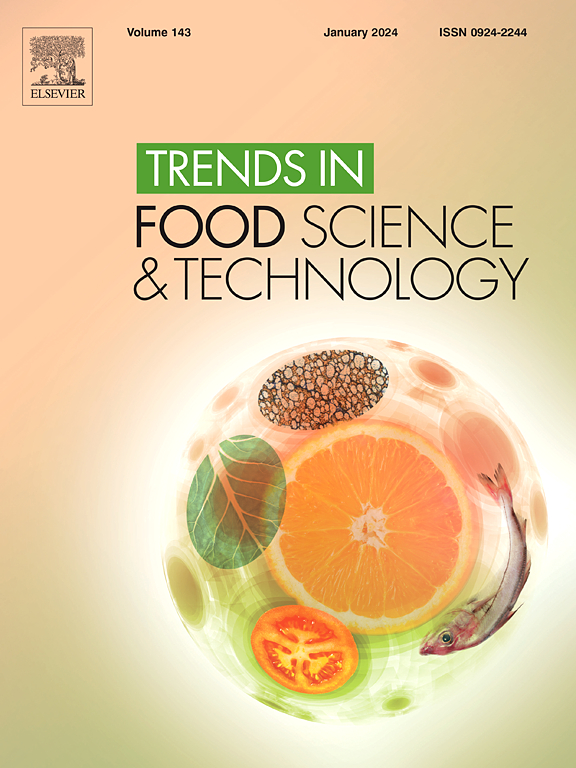Artificial intelligence for prediction of shelf-life of various food products: Recent advances and ongoing challenges
IF 15.1
1区 农林科学
Q1 FOOD SCIENCE & TECHNOLOGY
引用次数: 0
Abstract
Background
Accurate estimation of shelf-life is essential to maintain food safety, reduce wastage, and improve supply chain efficiency. Traditional methods such as microbial and chemical analysis, and sensory evaluation provide reproducible results but require time and labor and may not be suitable for real-time or high-throughput applications. The integration of artificial intelligence (AI) with advanced analysis techniques offers a suitable alternative for rapid, data-driven estimation of shelf-life in dynamic storage environments.
Approach and scope
The current review assesses the application of AI-based techniques such as machine learning (ML), deep learning (DL), and hybrid approaches in food product shelf life prediction. This study highlights how AI can be utilized to examine data from non-destructive testing methods like hyperspectral imaging, spectroscopy, machine vision, and electronic sensors to enhance predictive performance. The review also describes how AI-based techniques contribute to managing food quality, reduce economic losses, and enhance sustainability by ensuring optimized food distribution and reducing waste.
Key findings and conclusions
AI techniques overcome conventional techniques by considering intricate, multi-sourced information capturing microbiological, biochemical, and environmental factors influencing food spoilage. Meat, dairy, fruits and vegetables, and beverage case studies illustrate AI techniques' superiority in real-time monitoring and quality assessment. It also identifies limitations such as data availability, model generalizability, and computational cost, constraining extensive applications. Cloud and Internet of Things (IoT) platform integration into future applications has to be considered to enable real-time decision-making and adaptive modeling. AI can be a paradigm-changing tool in food industries with intelligent, scalable, and low-cost interventions in food safety, waste reduction, and sustainability.
预测各种食品保质期的人工智能:最新进展和持续挑战
准确估计保质期对于维护食品安全、减少浪费和提高供应链效率至关重要。传统的方法,如微生物和化学分析,感官评价提供可重复的结果,但需要时间和劳动力,可能不适合实时或高通量应用。人工智能(AI)与先进分析技术的集成为动态存储环境中快速,数据驱动的货架寿命估计提供了合适的替代方案。方法和范围本综述评估了基于人工智能的技术,如机器学习(ML)、深度学习(DL)和混合方法在食品保质期预测中的应用。这项研究强调了如何利用人工智能来检查来自非破坏性测试方法的数据,如高光谱成像、光谱学、机器视觉和电子传感器,以提高预测性能。该综述还描述了基于人工智能的技术如何通过确保优化食品分配和减少浪费来促进食品质量管理、减少经济损失和提高可持续性。ai技术通过考虑复杂的、多来源的信息来捕获影响食品腐败的微生物、生化和环境因素,从而克服了传统技术。肉类、乳制品、水果和蔬菜以及饮料的案例研究说明了人工智能技术在实时监控和质量评估方面的优势。它还确定了诸如数据可用性、模型通用性和计算成本等限制,从而限制了广泛的应用。必须考虑将云和物联网(IoT)平台集成到未来的应用程序中,以实现实时决策和自适应建模。在食品安全、减少浪费和可持续性方面,人工智能可以通过智能、可扩展和低成本的干预措施,成为食品行业改变范式的工具。
本文章由计算机程序翻译,如有差异,请以英文原文为准。
求助全文
约1分钟内获得全文
求助全文
来源期刊

Trends in Food Science & Technology
工程技术-食品科技
CiteScore
32.50
自引率
2.60%
发文量
322
审稿时长
37 days
期刊介绍:
Trends in Food Science & Technology is a prestigious international journal that specializes in peer-reviewed articles covering the latest advancements in technology, food science, and human nutrition. It serves as a bridge between specialized primary journals and general trade magazines, providing readable and scientifically rigorous reviews and commentaries on current research developments and their potential applications in the food industry.
Unlike traditional journals, Trends in Food Science & Technology does not publish original research papers. Instead, it focuses on critical and comprehensive reviews to offer valuable insights for professionals in the field. By bringing together cutting-edge research and industry applications, this journal plays a vital role in disseminating knowledge and facilitating advancements in the food science and technology sector.
 求助内容:
求助内容: 应助结果提醒方式:
应助结果提醒方式:


